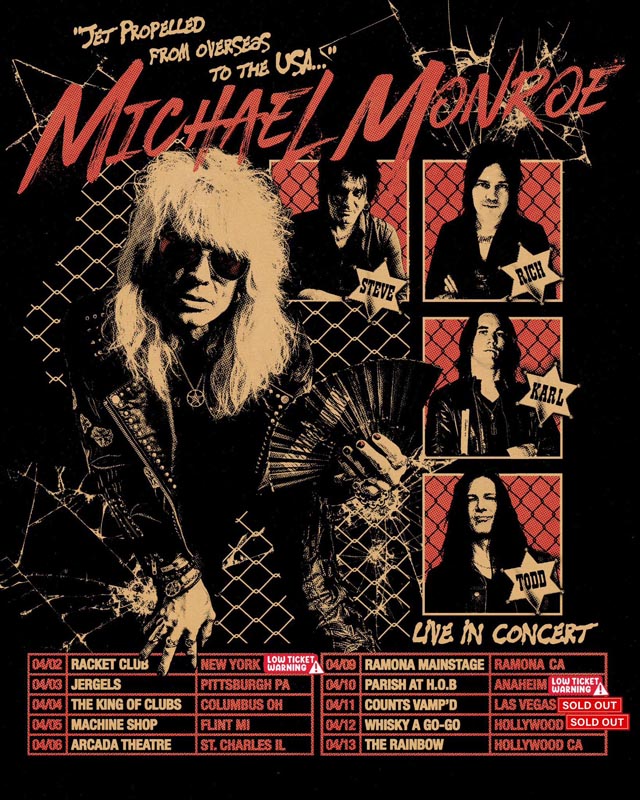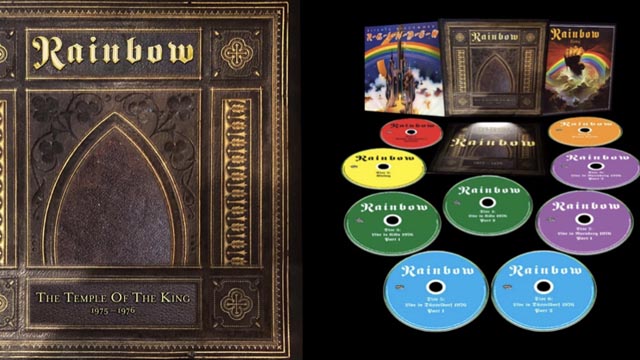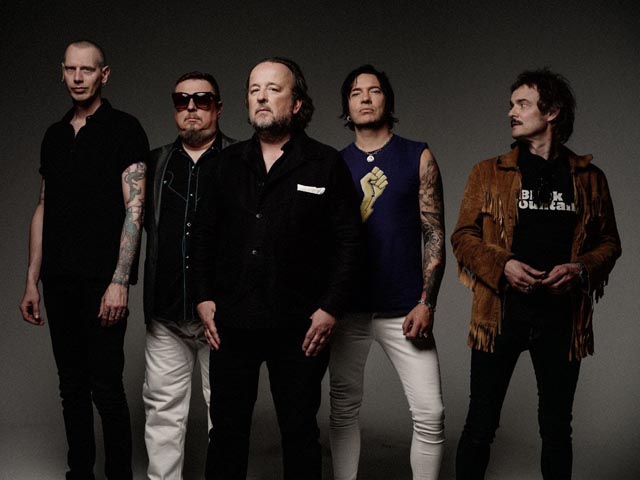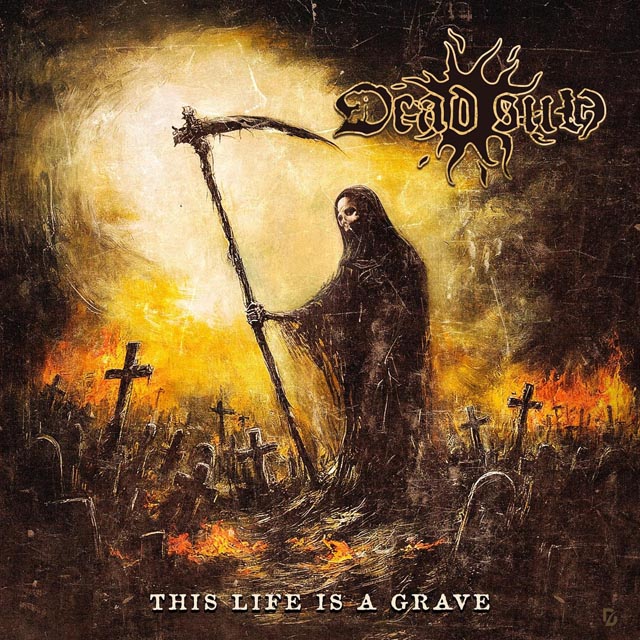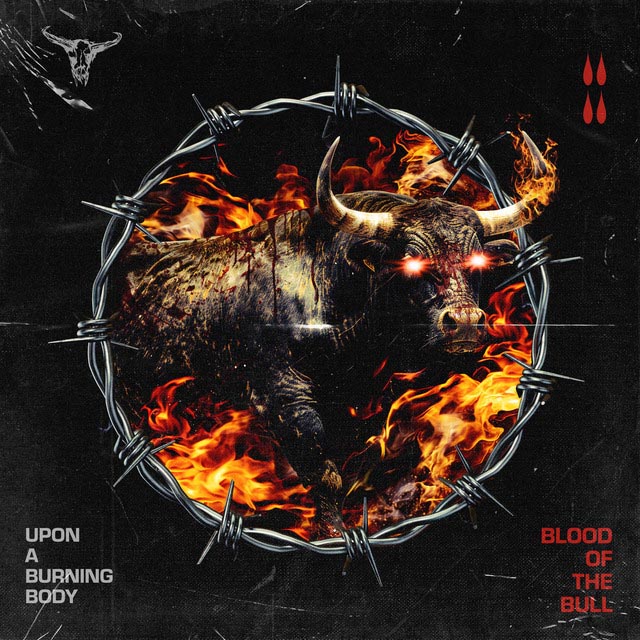
Things have seemingly never been better for Michael Monroe. The Finnish rock ‘n roll icon and ex-Hanoi Rocks frontman has been on a roll with his past few solo records, which have contained some of the most infectious, anthemic material he’s ever laid down. He’s also fresh off of a successful stint as coach on Finland’s version of TV musical reality show The Voice – true to Finnish awesomeness featuring a heavy dose of rock influence, as Monroe was joined by former Nightwish vocalist Tarja Tarunen as fellow coach. He’s certainly not slowing down several decades in from both triumphs and tragedies, as evidenced by recent opening gig for Guns ‘n Roses, video shoot for a new song, and Finnish tour that will take him up to October. Oh yeah, and there’s more TV work for him in the near future as well – a bit more about that later.
Much has been written about the influence Monroe’s had with Hanoi Rocks – every Sunset Strip rock ‘n roll band in the mid-1980’s worth its salt bowed down to the temple of Hanoi (looking your way G ‘n R, Motley, Faster Pussycat, etc). The 1985 breakup of the band had much to do with the death of drummer Nicholas “Razzle” Dingley in an infamous 1984 auto accident with Vince Neil at the wheel, snuffing out what was a burgeoning build for the band’s Two Steps From The Move album, and on a larger scale, one of the most notorious “should’ve been” success stories in rock lore. After just a handful of gigs in ’85, Monroe quit the band – he’d revisit the Hanoi legacy in the early 2000’s, but what immediately transpired is what we’re currently celebrating today – a solo career that’s hit the 30-year mark.
Michael Monroe has just released a solo career-spanning compilation through Finland’s Spinefarm Records titled Michael Monroe – The Best, which contains 29 tracks dating back to his 1987 solo debut, Nights Are So Long. The collection’s got some real gems, like a collaboration with Slash on the cover of Steppenwolf’s “Magic Carpet Ride,” new studio cut “One Foot Outta The Grave,” and “It’s a Lie” – the original cut appearing on Nights Are So Long, but here is a duet with Monroe’s longtime ally, the late Dead Boys frontman Stiv Bators.
Metal Insider had the chance to speak with Michael Monroe by phone from his home base in Finland recently, and as we soon found out by the small number of questions we were able to fit in during our allotted time, he was in incredibly good spirits and more than willing to give us the insider’s view of what led him to this quite fruitful solo journey. Monroe also talked about his relationship with former Hanoi Rocks guitarist Andy McCoy and the Hanoi legacy he’s tried to protect, his current solo band, some of his bluesier musical roots, and his stint on The Voice. Let it be known from here on out that any artist willing to treat an interviewer to a fiery harmonica solo over the phone is cool with us – thanks for that one, Michael.
So, Michael, this new “Best Of” collection is really a celebration of 30 years as a solo artist for you. What was it like for you when Nights Are So Long first came out, and you had some great input from people like Stiv Bators and Little Steven? Where was your headspace after Hanoi had ended and you were on your own?
It was a very significant period of time. Hanoi was breaking up and I was still living in London in the Spring of ’85 – Stiv was really the only friend I had back then. I was obviously still devastated from losing my best friend (Razzle) and having my band break up. Not only did Razzle die, but Sami Yaffa left the band. It was a very difficult time, but also with Stiv being there for me, it was such a help. He actually encouraged me to keep going – my intention was to save the integrity of the Hanoi Rocks name. There would have been some new guys coming into the band, and it would not have been the same as Hanoi had been, and I didn’t want that. I wanted people to know Hanoi Rocks as it was.
I moved in with Stiv eventually, in ’85, and Little Steven came over to produce the Lords of the New Church, and that’s when we made some demos, which he produced. These two people were like the coolest people in rock to me – I didn’t need anybody else. Steven was doing the Sun City project at the time, and that’s the first thing I did solo since Hanoi had broken up, and I’m still really proud to have been a part of that with all the people that were in it – Miles Davis to Pete Townsend, to Keith Richards to Ringo Starr, to Grandmaster Flash and Run DMC – all these great people. Then, when we went to do the video in New York, that’s when I decided to move to New York and start all over.
I was still recovering from this devastating blow, and Stiv encouraged me, we made those demos – we did a demo of “It’s a Lie,” where it’s a duet with Stiv. That’s the magical version of that song – it was written by Jimmy Zero, the Dead Boys’ guitarist. As we were recording it, Stiv realized the song was really about him leaving The Dead Boys. For me, it was really interesting because I had no plans and I didn’t know what I was going to do. More signs started pointing me in this direction, especially when I loved to New York. Stiv really showed me the ropes there – God bless that guy, he was really there for me; an important guy in my life and career. Stiv had showed Little Steven a Hanoi Rocks video, “Boulevard of Broken Dreams,” as Steven had never heard of us. He flipped out and said, “Wow, what a great band – what are you guys doing?” I told him the sad story about how our drummer died and we had broken up. Ever since he heard that, Little Steven has been supporting me in my career.
I had started writing songs again with the encouragement of Stiv, which I had given up on during the Hanoi years, because Andy (McCoy, Hanoi Rocks guitarist) always said he had a better song, and I allowed the situation to get to that point. But now, I was really getting excited about creating my own thing, and those guys had such a great work ethic – and the lyrics of the songs, like Stiv says on the cover of the first Lords of the New Church album, “The truth is destroyed of us all.” Little Steven’s Voice of America album was one of the most important albums to me, and still is – what he says in the lyrics is what I always wanted to do. That’s what the reggae guys do; there’s a message in the lyrics, raising questions – what the punk bands did back then as well, and what the original rap guys were doing. It was from the streets, shaking up the establishment, questioning authority, telling truths. That’s what I thought I should be doing, like I had a reason and a purpose to be up there on stage, not just saying, “Look at me, I’m…well, I used to be pretty (laughs).” To me, this was the key to my solo career and I really wanted to start writing songs with strong lyrics. I had something to say, and I wanted to work it into the music. The music I liked was a bit more straight-up and punkier, simpler rock ‘n roll, and with Hanoi, it was great because we defied all categories. We could do anything from punk to calypso. The music closer to my heart is what I’ve done solo.
Nights Are So Long, Stiv was supposed to produce that, but he couldn’t’ make it to the studio – he had some problems with the law back then. Therefore, the version of “It’s a Lie” that is on that album, I did by myself. That’s why it’s not nearly as good as the version that’s on this ‘Best Of” compilation with me and Stiv singing together. We were living together and we’d sing harmonies, and I can do a perfect Stiv Bators impression – we were the best of friends and I was a big fan. Singing harmonies together everyday, that has a certain kind of magic to it – almost like an Everly Brothers kind of vibe. The album was released originally only in Scandinavia and Japan, but with the help of that, I got signed to a major label in New York; Polygram Records signed me worldwide. That led to Not Fakin’ It as the first worldwide release.
So, with that, it came to pass that I started over. I survived that whole thing, and of course, it’s always a sore spot with Hanoi breaking up and Razzle and all that, but what else was I going to do but keep going? The most important thing about rock ‘n roll is the integrity, being true to who you are, and singing from the heart – that way you can reach people’s hearts. Do your own thing on your own terms – you don’t’ always have to be the biggest and the most famous. If you can do your own thing without compromise, you can be happy and on firm ground. That became very clear to me – no one can take away what I have.
Right now, I feel like I have the best band I’ve had in my solo career, with Sami Yaffa (bass), Steve Conte, Rich Jones (both guitar), and Karl Rockfist (drums). This band is going to keep doing what we’re doing, get better at it, and expand our fame – let people know. My dream is still to get on a big tour with some of the coolest, biggest bands like Foo Fighters or Alice Cooper or Guns ‘n Roses – bands like that that are really still cool and have the right kind of attitude and know rock ‘n roll. That’s what I’m thinking right now, and letting more people have a chance to know about this band. I guess that’s a long answer, but I guess that covers quite a bit, right? (laughs)
Absolutely! You know, as a big blues fan myself, I’ve always loved the blues influence in your music, and your harmonica playing…(Michael breaks into a few licks on harmonica over the phone). Man, you’re killin’ me with that, Michael! (laughs) Where did that blues influence come from for you?
Andy (McCoy) had given me a harp when we first met, we were like 14-15 or so. I said, “What is this?” He said, “It’s a harp.” I said, “Well, what do you do with it?” He said, “It’s all sucking and blowing.” So, there I am, practicing sucking and blowing, sucking and blowing (laughs). Because of that, I started getting into Willie Dixon and Little Walter – who I still think is the best harp player of all time, and a real pioneer. In those days in Finland, when I was growing up, they didn’t have genres like heavy metal or punk or glam, or anything like that. That’s why music was also better, because no one was trying to fit into any categories. The bands and artists had more personality and were doing for more of the right reasons. So, I was into reggae, and the blues, and funk music – we found this great band called Undisputed Truth, it was a Motown band. I guess their biggest hit was “Smiling Faces Sometimes.” We saw this album cover, Andy and I, called Higher Than High in a second-hand record store, with these five black guys with faces painted like Ace Frehley, platinum blonde afros and platform boots, floating in space. We said, “Whoa, we’ve got to get this record,” and it was the coolest funk. That album’s always been a part of me, in my blood. The blues; hadn’t seen much back then, but the more you live, the more you have the blues – it’s always there, it’s not a bad thing. The melancholy that a Finnish person always has in their nature, they enjoy their misery sometimes. I always say to make the most of your misery. But yeah, the blues has always been there, and I’ve always played my own style – Magic Dick from J. Geils Band, he’s incredible. He plays chromatic harp. The authentic blues sound with a bullet mic and some old vintage amp like a Fender Bassman or Fender Deluxe, that’s not really what I’m going for. For example, the song “Dead, Jail or Rock ‘n Roll,” that harp sound is going through one of the old Rockman boxes. It’s a harp going through a Shure 57 or 58 mic with the Rockman on the edgiest setting. I remember Little Steven came into the studio and says, “Man, what a great sound – what did you use?” I said, “Yeah, Rockman (laughs).”
When it comes to your solo material, Michael, I’m partial to the most recent stuff since Sensory Overdrive with Steve Conte, who is just an amazing talent. What’s it been like working with Steve for a number of years now?
Lovely! I feel blessed that he joined this band. It’s funny, because we were label mates in the early 90’s, around Not Fakin’ It. He was on Polygram as well, with the same A&R guy, Jim Lewis – Steve’s band was Company of Wolves. I didn’t really meet him back then, but since he’s joined this band, he’s been such a talented guitarist, great person and great songwriter. He and Rich Jones, the other guitarist, they’re like brothers now – there’s so much creative energy now, and we’re really, really happy. Steve’s my Keith (Richards) or Jimmy Page. We all have a great time on the road, as well; we really enjoy doing this. The chemistry is just exceptional, and that’s really rare – everybody is vital to this band.
You’ve always had a great guitarist or two at your side. You really personified the Jagger/Richards thing with Andy McCoy, so I’m curious, what was it like trying to work through the creative tension and also glorious partnership that you had with Andy?
There was a point when we started this band and me, Sami, and Nasty (Suicide, Hanoi Rocks guitarist) were on the streets – Andy had a girlfriend, so he had a home (laughs). There was a moment in the early years of the band where we kind of drifted apart from what it was originally, and we never really talked about it and never really were that open about it, so we never really got to know each other in that greater way. There was always some sort of tension and it wasn’t always easy – you never quite knew what his motivations were. It wasn’t until we got reacquainted in 2001 in Finland when I moved back here – he had gotten to respect my songwriting, ever since the Not Fakin’ It album. I remember he left me an answering machine message raving about the album, so, he had learned to respect my songwriting, which he hadn’t up until then. It was interesting when we got back together to see what we could accomplish – he’d had this accident where he fell off a three-story balcony where the doctor said he should be dead and he’ll never walk again. Sure enough, he’s not walking. My late wife had also just passed away at the time, so we had all these tragedies to base off of. It worked out for a while – I was up for doing it as long as it was fun; we made a few more good records as Hanoi Rocks. But, ironically, that was me and Andy, and the rest of the guys, but there came a point where it wasn’t’ fun anymore. I called Andy and I told him how I felt, I said, “Let’s put this band to rest with integrity intact and that will be good.”
Around this same time, this is when Sami came to Finland to play with the New York Dolls. HE invited me up on stage to jam, and we stayed up until about 4am that morning talking – he said he wanted to work with me again. I said, “Wow, that’s almost half the band there.” Through him, we got Steve, and I knew that this band felt like more of a band – even though it’s called Michael Monroe, it’s still more of a band situation than the reborn Hanoi Rocks situation ever was.
I can’t let you go without asking about your experience as a judge on the Finnish edition of The Voice – was it a positive experience for you? They don’t get a lot of rockers as panelists on the show.
Yeah – part of it was to keep me in touch with today’s music, and I saw I really wasn’t missing much, but then again, I wanted to keep an open mind. I had said no to all those things, and then the piano player of that band on the show called me and told me that it wasn’t about judging – I had always turned down things that were me judging other people’s work. This was about coaching, and inspiring the singers – I never forced them to sing anything, I just suggested things to them. I brought a lot of rock and roll into it – The Voice of Finland is very different from The Voice in other countries, I’ve noticed, and I was able to educate people about great songs and great bands that nobody knows about. In Finland, for example, nobody knows about Cheap Trick. I’ve had four Cheap Trick songs featured during all those seasons on The Voice, trying to educate people on this great band. I just saw them the other night in London, and they were fantastic. I was telling Tom Petersson about me getting the songs on The Voice we did “Surrender,” Tonight It’s You,” “The Flame,” and “Stop This Game,” all with different singers. I really enjoyed that because I was able to bring out a lot of great stuff. You know, the singers, a lot of them would try to do what everyone else is doing these days, and I’d try to suggest stuff from over the years that these guys would have never even heard. I just decided last season that it was time to move on.
Then, as I finished that, we had on The first season of The Voice in Finland, a singer named Saara Aalto, who finished second on The X Factor in the UK last season – now they want to start The X Factor in Finland where Saara Will be a coach and so will I – she’s become one of my best friends, and it will be great fun. On this show, you will be able to have real bands, rock bands in Finland, so that will be a new adventure for me. I don’t’ mind doing TV – it’s three or four months that you’re on the air and people see your face, and then it’s good to disappear for a while – even I get sick of my own face (laughs).
I love that you’re still game for trying new things like this!
You know, TV has an incredible effect on people. Through The Voice, I’ve gotten brand new fans – little kids under 10-years-old, over 90-year-olds, old ladies that will come up and say, “Oh, I really like your attitude, you’re so positive!” Also, because of all these shows where people get dissed, “don’t give up your day job because you can’t sing,” or other formats where people that don’t even sing themselves tell these young kids that they’re not good enough – you never tell someone that they’re not good enough, especially a young singer who is starting out their career. You can do it in a nice way, by giving honest advice and constructive criticism – something that’ll help the singer. I always stress that there’s an art to singing perfectly flawed – like Bob Dylan, for example. He’s been singing a little sharp his whole career, and it’s not been a bad career at all.


